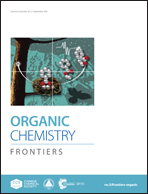Dual-directional alkyne-terminated macrocycles: Enroute to non-aggregating molecular platforms†
Abstract
Derivatized phthalocyanines (Pcs) and their heteroatom analogues, azaphthalocyanines (AzaPcs), bearing a variety of highly active ligands, have many advantageous properties that make them suitable as novel macrocyclic platforms. Many peripherally/non-peripherally functionalized macrocycles have been successfully employed as molecular platforms; however, due to the lack of directional control of the outward-facing reactive species, retaining their planarity while avoiding aggregation was quite challenging. The present work demonstrates the role of dual directionality using multivalent, orthogonal propargyl moieties based on two novel Zn(II)phthalocyanine (Pc1) and azaphthalocyanine (AzaPc1) complexes. These groups prevent the macrocyclic planar cores from self-associating in solution or in the solid state, as confirmed by 1H NMR, UV-Vis and single-crystal X-ray diffraction analyses. Such activated systems are thus highly applicable as key intermediates in the development of “molecular platforms” to generate endless, applicable, non-aggregated macrocyclic materials via a variety of organic transformations, specifically, the powerful click reaction, Cu(I)-catalysed azide–alkyne cycloaddition (CuAAC). In addition to their utility as efficient building blocks suitable for further modification, the photophysical/photochemical properties of these compounds were also investigated to determine their photocatalytic activities for valuable applications, such as in photodynamic therapy (PDT).



 Please wait while we load your content...
Please wait while we load your content...